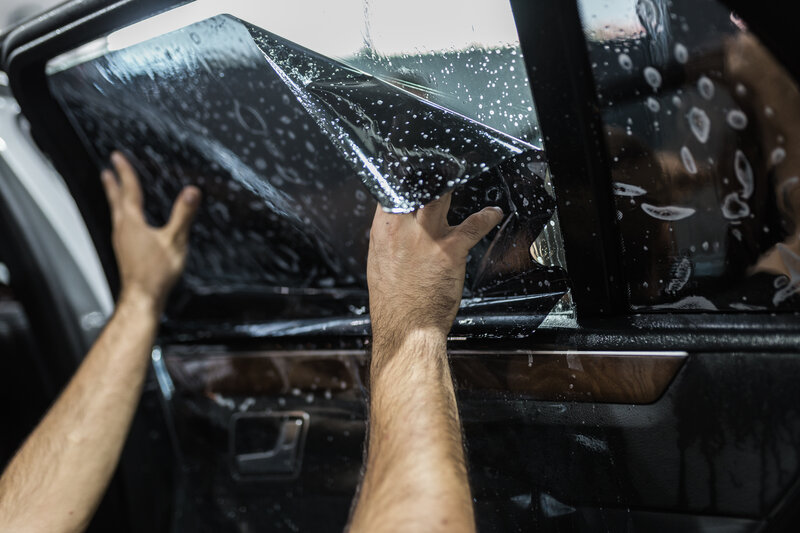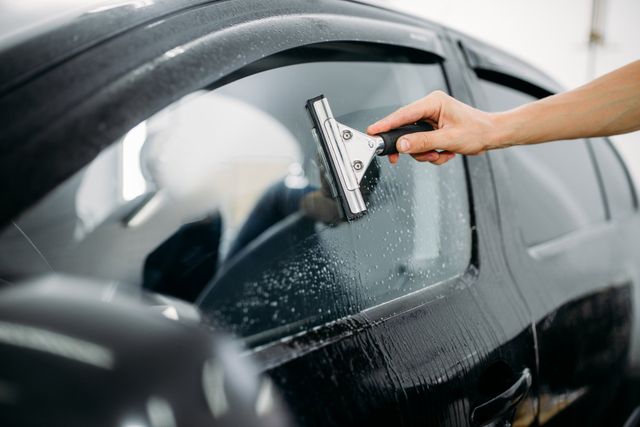Whatever You Required to Understand About Car Window Tinting for Your Lorry
Auto home window tinting is a practical improvement for many lorry owners. It provides benefits such as raised comfort and energy efficiency. Different tint films deal with various demands and preferences. Recognizing lawful guidelines and selecting the ideal color percentage is vital. The installation procedure and proper maintenance also play considerable roles in making sure the long life of the tint. What various other factors should one consider before deciding on home window tinting?
Advantages of Vehicle Home Window Tinting
Although some lorry owners may forget it, automobile home window tinting offers many benefits that boost both the driving experience and the car's long life. One of the main advantages is the decrease of heat accumulation inside the vehicle, enabling a much more comfortable experience, specifically during heat. This can lead to lowered reliance on air conditioning, boosting gas efficiency.Additionally, window tinting supplies security against damaging UV rays, which can create skin damages and discolor indoor products with time. By blocking these rays, the color aids preserve the vehicle's inside and keep its resale value.Moreover, colored home windows can improve personal privacy and safety, as they make it harder for outsiders to see inside the car. This added layer of protection can prevent possible theft. Generally, automobile home window tinting serves as a practical financial investment that contributes to the car and both convenience's overall wellness.
Sorts Of Window Tint Films
When considering auto home window tinting, vehicle owners run into a selection of window color films, each designed to satisfy particular needs and choices. The first classification is dyed window movie, which offers a fundamental level of personal privacy and UV protection while being cost-efficient. Next off, metalized movies include tiny metal fragments, mirroring heat and boosting longevity, although they may conflict with digital signals.Ceramic films are an additional alternative, understood for their remarkable heat rejection and clearness, offering high efficiency without signal interference. Crossbreed movies integrate features of colored and metalized films, striking an equilibrium between price and performance. Each kind of home window tint movie offers distinct benefits, allowing vehicle proprietors to pick based upon their details needs, such as warmth budget plan, control, and appearance considerations. Recognizing these options is vital for making an educated choice relating to auto window tinting.
Recognizing Lawful Laws
When considering vehicle home window tinting, it is critical to understand the lawful policies that regulate tint darkness limits and windscreen tint needs. These regulations can differ considerably from state to state, influencing what is permissible for lorry owners. Acquainting oneself with these regulations warranties conformity and aids prevent prospective penalties or fines.
Color Darkness Limits
How can vehicle proprietors guarantee they stay compliant with regional legislations pertaining to home window tinting? Comprehending tint darkness restrictions is important. Each state has details guidelines that dictate the permissible levels of darkness for home window tints, which are measured by Visible Light Transmission (VLT) portions. Typically, front-side home windows have to permit a higher percent of light contrasted to back windows. For instance, some states might permit just 30% VLT for front home windows, while the rear home windows could be allowed to have especially darker tints. To guarantee conformity, lorry proprietors should seek advice from state standards or regional police for precise details. Additionally, licensed tinting professionals can supply insights about legal restrictions, guaranteeing that lorry proprietors make informed choices.
Windscreen Color Laws

State-Specific Legislations
Steering with the landscape of state-specific legislations concerning vehicle window tinting calls for careful focus to information, as guidelines can differ considerably from one state to one more. Each state has its very own set of rules regulating permitted color percents, kinds of materials, and positioning on car windows. Some states allow darker colors on back home windows while banning them on front home windows, while others have more stringent total limitations (automotive window tinting clinton township). Additionally, specific states mandate using details products or call for certification from installers. Failure to follow these laws can result in fines or the need to remove non-compliant color. Car owners should consult their state's Division of Motor Cars or appropriate authority to assure adherence to regional legislations.
Choosing the Right Tint Portion
When picking the best color percentage for an automobile's home windows, one should think about numerous elements that affect both looks and capability. Tint percentages commonly vary from 5% to 70%, with reduced percentages providing darker tones and greater percentages permitting a lot more light in. A darker color can improve personal privacy and decrease glow, while a lighter color can maintain presence and follow lawful restrictions.Furthermore, personal choice plays a significant function in this choice. Some individuals might favor the smooth appearance of darker tints, while others could favor a much more open, airy feel. Additionally, the lorry's purpose ought to be considered; as an example, those using their lorries for commercial objectives could select lighter tints to keep an expert look.Ultimately, the right color percent balances personal design, comfort, and adherence to local laws, making certain a gratifying tinting experience.
The Installment Process
A successful installment of home window tint calls for cautious interest to detail and the right tools. The process generally begins with detailed cleaning of the windows to remove dust, debris, and dirt, guaranteeing appropriate bond of the movie. Once the surfaces are prepared, the installer actions and cuts the color movie to fit each home window accurately.Next, the film is positioned on the glass, usually utilizing an option to promote easy adjustment and avoid air bubbles. Heat is in some cases applied to the film to adhere it to the home window's curves, enhancing its appearance and durability. After his comment is here verifying a seamless fit, the visit the site installer thoroughly cuts any excess movie along the edges.Finally, the installer look for imperfections and confirms all edges are safe. This precise approach is crucial not only for aesthetics however also for accomplishing the wanted performance advantages of home window tinting, such as UV defense and heat decrease.
Maintenance and Care for Tinted Windows
Correct upkeep and care are essential for protecting the honesty of tinted home windows. Efficient cleaning strategies, the avoidance of hazardous chemicals, and regular inspections for damage play vital functions in making certain longevity. By following these guidelines, car proprietors can preserve the aesthetic and functional advantages of their window tint.
Cleansing Methods for Tint
Maintaining the clarity and long life of tinted windows needs specific cleaning techniques customized to the film's delicate surface area. It is important to utilize a soft microfiber fabric to prevent scratching the tint while cleansing. A mild solution of water and a couple of drops of light recipe soap can properly remove dirt and grime. It is recommended to use the cleaning solution to the towel, as opposed to straight onto the tinted surface area, to stop dampness from permeating right into the edges of the film. Mild, round motions need to be utilized to clean up the windows thoroughly. Normal cleaning assists keep visibility and avoids accumulation, guaranteeing that the color remains in prime problem with time. Adhering to these strategies will prolong the life of tinted home windows.
Avoiding Harmful Chemicals
Although numerous house cleaning products work on various surfaces, they can posture substantial risks to colored windows. Chemicals such as ammonia, bleach, and particular solvents can break down the tint movie, bring about staining and peeling. People must opt for pH-balanced cleaners specifically developed for tinted windows. Furthermore, utilizing soft microfiber towels will certainly help prevent scratches and preserve the tint's stability. Routine upkeep is important; consequently, avoiding severe scrubbing or abrasive products is essential. It is suggested to review product tags very carefully to validate compatibility with home window tints. By choosing the ideal cleaning services and tools, vehicle proprietors can maintain the look and performance of their colored home windows, ensuring a longer life-span and peak performance.
Checking for Damages
Regular inspections of tinted home windows are crucial for identifying any indicators of damages that may jeopardize their effectiveness and look. Owners need to seek bubbling, peeling off, or staining, as these concerns can indicate poor installment or exposure to dangerous aspects. It is suggested to examine the edges of the film where peeling may inspect and begin for any type of scratches that could influence exposure. Additionally, ultraviolet (UV) rays can trigger the tint to break down gradually, so monitoring its efficiency in obstructing UV light is critical. If any type of damages is spotted, prompt action must be taken, which may consist of expert repair or replacement. Maintaining tinted windows not just boosts aesthetic appeals but additionally guarantees proceeded security for both passengers and the lorry inside.
Common Myths About Home Window Tinting
What false impressions border home window tinting for automobiles? Numerous people believe that all window colors are prohibited, however guidelines differ by state, enabling particular levels of tinting. An additional usual myth is that darker colors block more heat; nevertheless, the performance of home window movies depends on their technology as opposed to darkness. Some individuals also assume that window tinting is exclusively for aesthetics, neglecting its advantages, such as UV defense and glare reduction. Furthermore, numerous think that window tinting will harm their automobile's glass, however properly applied tints can actually boost glass toughness. Finally, there is a belief that window colors obstruct exposure, yet high-quality advice movies are created to preserve clear sightlines while offering privacy. Comprehending these misconceptions aids consumers make informed choices pertaining to window tinting, guaranteeing they delight in the full series of benefits it offers.
Frequently Asked Inquiries
The Length Of Time Does Home Window Tinting Normally Last?
The long life of window tinting varies based upon aspects such as setup quality, movie kind, and ecological problems. Usually, top notch tint can last anywhere from 5 to ten years prior to needing substitute or reapplication.
Can I Get Rid Of Window Color Myself?
Eliminating window color oneself is possible, though it might be tough. Individuals ought to use a heat resource and glue cleaner to ease the procedure, yet care is suggested to prevent damaging the automobile's glass or inside.
What Tools Are Needed for Do It Yourself Home Window Tinting?

Will Window Tinting Damages My Car's Glass?
Window tinting, when applied properly, generally does not harm a cars and truck's glass. However, improper installment or low-grade films may lead to peeling, bubbling, or damaging, potentially compromising the integrity of the glass in time.
Can Tinted Windows Influence My Lorry's Resale Value?
The influence of colored windows on a lorry's resale worth can vary. While some buyers value the added personal privacy and UV defense, others might view it as a potential problem, possibly impacting resale positively or negatively. When considering vehicle home window tinting, vehicle owners experience a selection of home window tint movies, each designed to fulfill certain needs and preferences. When considering car window tinting, it is important to understand the lawful laws that regulate tint darkness limitations and windscreen color requirements. Typically, front-side home windows should enable a greater portion of light contrasted to rear home windows. Some states might allow only 30% VLT for front home windows, while the rear home windows could be permitted to have significantly darker colors. Some states allow darker tints on rear home windows while restricting them on front home windows, while others have stricter overall limitations.